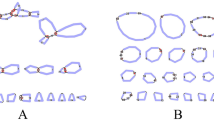Abstract
For a long time, the evolutionary relationship between human and African apes, the 'trichotomy problem', has been debated with strong differences in opinion and interpretation. Statistical analyses of different molecular DNA data sets have been carried out and have primarily supported a Homo—Pan clade. An alternative way to address this question is by the comparison of evolutionarily relevant chromosomal breakpoints. Here, we made use of a P1-derived artificial chromosome (PAC)/bacterial artificial chromosome (BAC) contig spanning approximately 2.8 Mb on the long arm of the human Y chromosome, to comparatively map individual PAC clones to chromosomes from great apes, gibbons, and two species of Old World monkeys by fluorescence in-situ hybridization. During our search for evolutionary breakpoints on the Y chromosome, it transpired that a transposition of an approximately 100-kb DNA fragment from chromosome 1 onto the Y chromosome must have occurred in a common ancestor of human, chimpanzee and bonobo. Only the Y chromosomes of these three species contain the chromosome-1-derived fragment; it could not be detected on the Y chromosomes of gorillas or the other primates examined. Thus, this shared derived (synapomorphic) trait provides clear evidence for a Homo—Pan clade independent of DNA sequence analysis.
Similar content being viewed by others
References
Andrews P (1992) Evolution and environment in the hominoidea. Nature 360: 641–646.
Caccone A, Powell JR (1989) DNA divergence among hominoids. Evolution 43: 925–942.
Chen F-C, Li W-H (2001) Genomic divergences between humans and other hominoids and the effective population size of the common ancestor of humans and chimpanzees. Am J Hum Genet 68: 444–456.
Djian P, Green H (1989) Vectorial expansion of the involucrin gene and the relatedness of the hominoids. Proc Natl Acad Sci USA 86: 8447–8451.
Ferris SD, Wilson AC, Brown WM (1981) Evolutionarytree for apes and humans based on cleavage maps of mitochondrial DNA. Proc Natl Acad Sci USA 78: 2432–2436.
Gibbs S, Collard M, Woods B (2000) Soft-tissue characters in higher primate phylogenetics. Proc Natl Acad Sci USA 97: 11130–11132.
Gläser B, Grützner F, Willmann U et al. (1998) Simian Y chromosomes: species-specific rearrangements of DAZ, RBM, and TSPY versus contiguityof PAR and SRY. Mammalian Genome 9: 226–231.
Gläser B, Myrtek D, Rumpler Y et al. (1999) Transposition of SRY into the ancestral pseudoautosomal region creates a new pseudoautosomal boundaryin a progenitor of simian primates. Hum Mol Genet 8: 2071–2078.
Goldman D, Rathna Giri P, O'Brien SJ (1987) A molecular phylogeny of the hominoid primates as indicated by two-dimensional protein electrophoresis. Proc Natl Acad Sci USA 84: 3307–3311.
Goodman M, Porter CA, Czelusniak J et al. (1998) Toward a phylogenetic classification of primates based on DNA evidence complemented byfossil evidence. Mol Phylogenet Evol 9: 585–598.
Horai S, Satta Y, Hayasaka K et al. (1992) Man's place in hominoidea revealed bymitochondrial DNA genealogy. J Mol Evol 35: 32–43.
Huxley TH (1863) Evidence as to Man's Place in Nature. New York: P. Appleton & Co.
Jauch A, Wienberg J, Stanyon R et al. (1992) Reconstruction of genomic rearrangements in great apes and gibbons by chromosome painting. Proc Natl Acad Sci USA 89: 8611–8615.
Ji Y, Eichler EE, Schwartz S, Nicholls RD (2000) Structure of chromosomal duplicons and their role in mediating human genomic disorders. Genome Res 10: 597–610.
Jobling MA, Tyler-Smith C (2000) New uses for new haplotypes, the human Y chromosome, disease and selection. Trends Genet 16: 356–362.
Kawamura S, Tanabe H, Watanabe Y, Kurosaki K, Saitou N, Ueda S (1991) Evolutionaryrate of immunoglobulin alpha noncoding region is greater in hominoids than in Old World monkeys. Mol Biol Evol 8: 743–752.
Lahn BT, Page D (1999) Four evolutionarystrata on the human X chromosome. Science 286: 964–967.
Martin RD (1993) Primate origins: plugging the gaps. Nature 363: 223–234.
Rao E, Weiss B, Fukami M et al. (1997) Pseudoautosomal deletions encompassing a novel homeobox gene cause growth failure in idiopathic short stature and Turner syndrome. Nature Genet 16: 54–63.
Ried T, Lengauer C, Cremer T et al. (1992) Specific metaphase and interphase detection of the breakpoint region in 8q24 of Burkitt lymphoma cells by triple-color fluorescent in situ hybridization. Genes Chrom Cancer 4: 69–74.
Rogers J (1994) Levels of the genealogical hierarchy and the problem of hominoid phylogeny. Am J Phys Anthropol 94: 81–88.
Ruvolo M (1997) Molecular phylogeny of the hominoids: inferences from multiple independent DNA sequence data sets. MolBiolEvol 14: 248–265.
Sargent CA, Boucher CA, Kirsch S et al. (1999) The critical region of overlap defining the AZFa male infertilityinterval of proximal Yq contains three transcribed sequences. J Med Genet 36: 670–677.
Sarich V, Wilson AC (1967) Immunological time scale for hominid evolution. Science 158: 1200–1203.
Satta Y, Klein J, Takahata N (2000) DNA archives and our nearest relative: the trichotomyproblem revisited. Mol Phylogenet Evol 14: 259–275.
Schempp W, Binkele A, Arnemann J et al. (1995) Comparative mapping of YRRM- and TSPY-related cosmids in man and hominoid apes. Chrom Res 3: 227–234.
Semino O, Passarino G, Oefner PJ et al. (2000) The genetic legacyof paleolithic Homo sapiens sapiens in extant Europeans: a Y chromosome perspective. Science 290: 1155–1159.
Shen P, Wang F, Underhill PA et al. (2000) Population genetics implications from sequence variation in four Y chromosome genes. Proc Nat Acad Sci USA 97: 7354–7359.
Sibley CG, Alquist JE (1984) The phylogeny of the hominoid primates, as indicated by DNA–DNA hybridization. Mol Evol 20: 2–15.
Sibley CG, Alquist JE (1987) DNA hybridization evidence of hominoid phylogeny, results from an expanded data set. J Mol Evol 26: 99–121.
Sibley CG, Comstock JA, Alquist JE (1990) DNA hybridization evidence of hominoid phylogeny: reanalysis of the data. J Mol Evol 30: 202–236.
Smit AFA, Riggs AD (1996) Tiggers and other DNA transposon fossils in the human genome. Proc Nat Acad Sci USA 93: 1443–1448.
Author information
Authors and Affiliations
Rights and permissions
About this article
Cite this article
Wimmer, R., Kirsch, S., Rappold, G.A. et al. Direct Evidence for the Homo—Pan Clade. Chromosome Res 10, 55–61 (2002). https://doi.org/10.1023/A:1014222311431
Issue Date:
DOI: https://doi.org/10.1023/A:1014222311431




